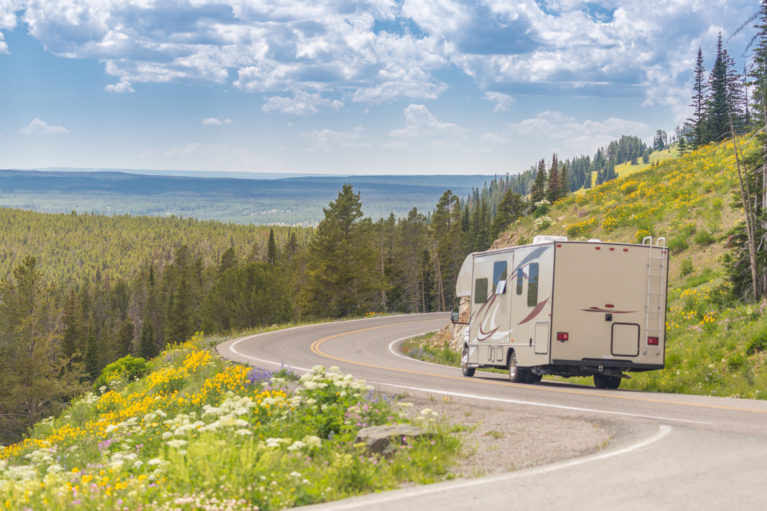8 Great Motorhome Driving Tips
Whether you’ve just purchased a new motorhome or you’re planning to find one on finance ahead of your next holiday, the sense of freedom it brings cannot be beaten. It opens the door to a whole world of new and exciting adventures and is set to deliver magical memories that last a lifetime.
Before setting off on your first journey, though, you must acknowledge that it’s not the same as driving a car or work van. As such, you need to ensure that the right preparations have been made to ensure optimal safety, comfort, and enjoyment.
Here are eight essential motorhome driving tips that will enrich your adventures and provide peace of mind. Happy road tripping!

#1 Check The Legal Requirements
Before you start driving any motorhome or larger vehicle, you must first confirm that you are legally permitted to do it. This will largely be determined by two factors; the weight of the vehicle and how long you’ve had your driving licence. If you started driving before 1997, you are automatically able to drive C1 vehicles, up to 7,500kg.
However, if you got your license from 1997 onwards, you are only permitted to drive a vehicle up to 3,500kg. Most motorhome manufacturers naturally make products under this limit to reach a wider audience. If the vehicle surpasses this threshold, though, you will be required to gain an additional license before hitting the road.
#2 Familiarise Yourself With The Vehicle
The most obvious difference between driving a car and a motorhome is the size. Your motorhome will be taller, wider, and heavier than the hatchback or MPV you use for driving around town. Aside from potentially making some routes inaccessible, it will significantly impact the handling and performance.
Consequently, then, you need to familiarise yourself with the impact of those dimensions and weights.
Your manual will tell you the factual data. However, it’s best to take a test drive in a quiet, local area to get a feel for the motorhome. This will reduce any threat of accidents on the road and essentially make you a better, more confident driver.
#3 Know Your Destination
An understanding of your ride is one thing, but you also need to prepare for the journeys themselves. Our guide to driving in the EU in the post-Brexit era is vital reading for anyone heading to the continent. However, holidaymakers choosing domestic staycations will also need to plan their routes.
From knowing the best roads and having an accurate ETA to checking any regulations at a campsite or holiday park, a little research goes a long way to boosting the quality of your adventure. Likewise, knowing what attractions and activities are available will guide your pre-trip packing decisions.
#4 Check Your Mirrors
When driving a motorhome, the extra width can make a big difference, not least because the average motorhome is around 1m wider than a standard family car. This could put you at risk of crossing the middle of the road. With the mirrors positioned to show around ¼ of the vehicle’s side, you’ll know where you are in relation to road markings.
Even so, you could end up with blindspots despite the best efforts of manufacturers. Auxiliary mirrors, which are clipped onto the end of the standard mirrors, will extend the field of vision and improve your safety on the road. Aside from preventing accidents, it will make manoeuvring around difficult spaces far simpler.
#5 Focus On Speed & Distance
Firstly, legal restrictions on the speed at which you can drive your vehicle must be respected. While it is possible to drive at 70mph on the motorways, you will need to drop the speed to 60mph or 30mph on smaller roads and single carriageways. Meanwhile, heavier motorhomes are limited to 60mph on dual carriageways too. This is in addition to the standard speed limits.
When driving your motorhome, it’s also very important to familiarise yourself with the necessary braking distances. A heavier vehicle takes longer to brake than your small car. As such, it’s always wise to drop back from the vehicle in front. When travelling at a high speed, it will impact the way you change lanes too. Be conservative to maintain optimal safety.
#6 Add Assistive Tech
When you buy a new motorhome, it’s likely that the model will include a host of tech features as standard to assist your driving habits. However, it’s worth checking that your vehicle has the tools needed to enhance your time behind the wheel from a safety perspective, as well as for the sake of your sanity.
Given that you’ll be driving unfamiliar routes, a reliable satellite navigation system is essential. Bluetooth speakers for hands-free calling, parking sensors, and dash cams are also very useful additions. When supported by the best motorhome gadgets, your entire road trip experience will improve.
#7 Pay Extra Attention To Parking
Good visibility and an appreciation of the speed, distance, and dimensions should serve you well on motorways, A roads, and even off-road driving once you enter a destination. Nonetheless, perhaps the hardest challenge for a motorhome driver stems from parking. If one of your passengers can get out to guide you, then take it.
Whether it’s parking on the site, a service station, or your home driveway, the best option is to avoid obstacles that could pose a threat. Once again, your mirrors will be vital while rearview cameras can offer guidance too. Don’t rely on just one item, though, as you need the full field of vision. Finally, don’t be afraid to take your time.
#8 Have Confidence
Acclimatising to driving a motorhome will take a little time. However, the journey ahead will be far tougher if you drive with a sense of self-doubt. As an experienced driver, you already boast years of experience and knowledge. In short: if you can drive a family car, you are more than capable of driving a motorhome.
Frankly, having a little confidence is the most important motorhome driving tip of all, and there’s no doubt that embracing the other steps above will allow you to get it right. With the right mindset, the road to successful motorhome ownership will be smoother than you ever thought possible!
Get a Quote
payments of
Cash price £15,000, deposit £0, total amount of credit £15,000, term 7 years, 84 monthly payments of £237.97, on a hire purchase agreement, option to purchase fee £1, total amount payable £19,989.69, representative APR 8.9%, rate of interest 8.9% fixed.
Rates may differ as they are dependent on individual circumstances. Subject to status.

